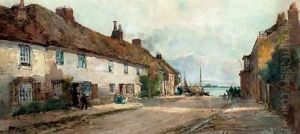Georges Charles Haite Paintings
Georges Charles Haite, born in 1855 in London, England, was a notable figure in the world of art and design during the late 19th and early 20th centuries. His contributions spanned across various disciplines including painting, illustration, and decorative arts, making him a versatile and influential artist of his time. Haite's work was deeply influenced by the Art Nouveau movement, which was characterized by its use of organic forms, flowing lines, and incorporation of botanical motifs. This influence is evident in much of Haite's work, which often features elaborate designs and a keen attention to detail.
Haite's education and early career were rooted in the vibrant artistic environment of London, where he was exposed to a wide range of artistic styles and movements. He quickly developed a distinct style that combined elements of traditional British art with the emerging trends of Art Nouveau. Throughout his career, Haite was actively involved in the arts community, contributing to various exhibitions and publications. His work was featured in many important exhibitions of the time, including those held by the Royal Academy of Arts, showcasing his versatility and skill across different mediums.
Beyond his contributions to painting and illustration, Georges Charles Haite was also recognized for his work in the decorative arts. He designed wallpapers, textiles, and even furniture, applying his unique style to create pieces that were both beautiful and functional. This aspect of his work highlighted his belief in the unity of all arts and the importance of creating aesthetically pleasing environments. Haite's influence extended beyond his own creations, as he mentored younger artists and promoted the principles of the Arts and Crafts Movement, advocating for craftsmanship and quality in the face of industrial mass production.
Georges Charles Haite's legacy is that of an artist who embraced the beauty of the natural world and sought to integrate it into everyday life through his art. He passed away in 1924, leaving behind a body of work that continues to be celebrated for its elegance, intricacy, and contribution to the Art Nouveau movement. His influence can still be seen in the appreciation for craftsmanship and design that characterizes much of contemporary art and design.
